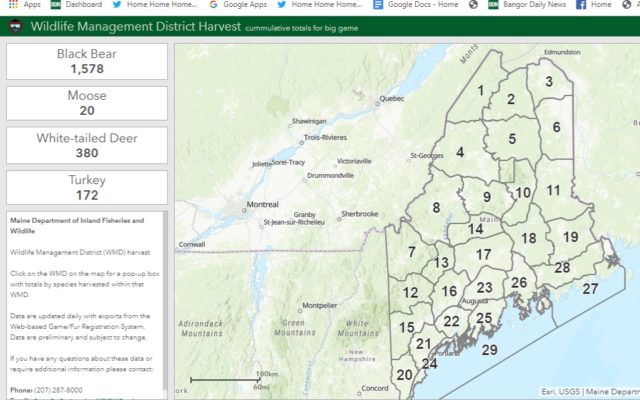
This cool tool will let you see how many moose (or deer, or bears) hunters have tagged
Just two short years ago, anyone wondering how successful the state’s hunters had been in a given season had only one way to get that information.
First, they’d have to wait for several months. Then they could contact the Maine Department of Inland Fisheries and Wildlife. And finally (if all of the paper tagging booklets had been mailed to Augusta from all of the state’s far-flung tagging stations), a biologist would be happy to provide the answer.
Now, thanks to advancements made over the past year, that data is available instantly. All you need is a phone, tablet or computer, and the ability to navigate to the DIF&W’s Harvest Information page (www.maine.gov/ifw/hunting-trapping/harvest-information.html) where there’s a link in the right sidebar.
Do that, as I just did, and you’ll end up on the DIF&W’s Wildlife Management District harvest dashboard. And in less time than it took to type this sentence, I was able to learn than 1,578 bears, 20 moose, 380 deer and 172 wild turkeys have been tagged thus far in the seasons that are in progress or recently completed.
Nothing to it.
A year ago, the state unveiled its web-based big game registration program. The program required tagging station staffers to enter information into a computer rather than on a sheet of paper, as had been the custom for years, every time a deer, moose, wild turkey or bear was brought in to be tagged.
Because of that change, state wildlife biologists and game wardens could access records instantly, and not only see the number of a particular big game animal that had been harvested, but find the names of every hunter who’d tagged an animal.
Given that capability, DIF&W wildlife division director Nate Webb said that allowing the public to view some of that data was a logical next step.
“Last year, once word got out to the hunting community, and even the broader general public, about the new system, we were getting a lot of calls and email requests for updates on what the harvest was to that point of the season,” Webb said. “We just realized that there was a lot of interest in having that information, and it was actually relatively straight-forward for us to build that little application.”
While the site is great for getting statewide totals, it also allows the user to dig deeper and get much more localized data.
Curious if the deer season in your neck of the woods has been tough on your fellow hunters? Go to the site, click on your Wildlife Management District on the attached map, and you’ll get a thumbnail breakdown of the tagging info from that zone.
In WMD 26, for instance, a single click showed that a total of 28 bears, 41 deer and 14 turkeys had been registered.
The site will be particularly useful during moose season, as curious folks will be able to track how the hunt is going, district-by-district, if they choose. With the number of hunters limited by the state, it will be a simple task to see what percentage of the 2,820 hunters have filled their tags as the seasons progress.
Webb said he expects the department to continue this trend toward easily accessible data.
“We’re generally making a pretty major move, just using technology more, using real time information, databases, and just moving away from paper forms and manual data entry,” Webb said. “This registration system was kind of the first big project that we did in that direction, but we’re actively pursuing more and more types of information. We expect, in general, to have our information more accessible both through our own staff and to the public as well.”